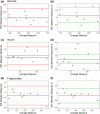A systems biology approach to understand gut microbiota and host metabolism in morbid obesity: design of the BARIA Longitudinal Cohort Study
- PMID: 32640105
- PMCID: PMC7984244
- DOI: 10.1111/joim.13157
A systems biology approach to understand gut microbiota and host metabolism in morbid obesity: design of the BARIA Longitudinal Cohort Study
Abstract
Introduction: Prevalence of obesity and associated diseases, including type 2 diabetes mellitus, dyslipidaemia and non-alcoholic fatty liver disease (NAFLD), are increasing. Underlying mechanisms, especially in humans, are unclear. Bariatric surgery provides the unique opportunity to obtain biopsies and portal vein blood-samples.
Methods: The BARIA Study aims to assess how microbiota and their metabolites affect transcription in key tissues and clinical outcome in obese subjects and how baseline anthropometric and metabolic characteristics determine weight loss and glucose homeostasis after bariatric surgery. We phenotype patients undergoing bariatric surgery (predominantly laparoscopic Roux-en-Y gastric bypass), before weight loss, with biometrics, dietary and psychological questionnaires, mixed meal test (MMT) and collect fecal-samples and intra-operative biopsies from liver, adipose tissues and jejunum. We aim to include 1500 patients. A subset (approximately 25%) will undergo intra-operative portal vein blood-sampling. Fecal-samples are analyzed with shotgun metagenomics and targeted metabolomics, fasted and postprandial plasma-samples are subjected to metabolomics, and RNA is extracted from the tissues for RNAseq-analyses. Data will be integrated using state-of-the-art neuronal networks and metabolic modeling. Patient follow-up will be ten years.
Results: Preoperative MMT of 170 patients were analysed and clear differences were observed in glucose homeostasis between individuals. Repeated MMT in 10 patients showed satisfactory intra-individual reproducibility, with differences in plasma glucose, insulin and triglycerides within 20% of the mean difference.
Conclusion: The BARIA study can add more understanding in how gut-microbiota affect metabolism, especially with regard to obesity, glucose metabolism and NAFLD. Identification of key factors may provide diagnostic and therapeutic leads to control the obesity-associated disease epidemic.
Keywords: bariatric surgery; gut microbiota; insulin resistance; metabolites; obesity.
© 2020 The Authors. Journal of Internal Medicine published by John Wiley & Sons Ltd on behalf of Association for Publication of The Journal of Internal Medicine.
Conflict of interest statement
MN is in the Scientific Advisory Board of Caelus Pharmaceuticals, the Netherlands and Kaleido Bioscience, USA; FB is in the Scientific Advisory Board of MetaboGen AB, Sweden. None of these are directly relevant to the current paper. There are no patents, products in development or marketed products to declare. The other authors declare no conflicts of interests.
Figures




References
-
- Kelly T, Yang W, Chen C‐S, Reynolds K, He J. Global burden of obesity in 2005 and projections to 2030. Int J Obes (Lond) 2008; 32: 1431–7. - PubMed
-
- Ahlqvist E, Storm P, Käräjämäki A et al. Novel subgroups of adult‐onset diabetes and their association with outcomes: a data‐driven cluster analysis of six variables. Lancet Diabetes Endocrinol 2018; 6: 361–9. - PubMed
-
- Park HS, Park JY, Yu R. Relationship of obesity and visceral adiposity with serum concentrations of CRP, TNF‐alpha and IL‐6. Diabetes Res Clin Pract 2005; 69: 29–35. - PubMed
-
- Ley RE, Turnbaugh PJ, Klein S, Gordon JI. Microbial ecology: human gut microbes associated with obesity. Nature 2006; 444: 1022–3. - PubMed
-
- Tremaroli V, Bäckhed F. Functional interactions between the gut microbiota and host metabolism. Nature 2012; 489: 242–9. - PubMed
Publication types
MeSH terms
Substances
LinkOut - more resources
Full Text Sources
Medical
Research Materials

